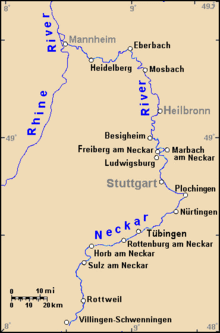Besigheim | |
|---|---|
 | |
 Coat of arms | |
Location of Besigheim within Ludwigsburg district  | |
 Besigheim  Besigheim | |
| Coordinates: 48°59.9′N 9°8.5′E / 48.9983°N 9.1417°E | |
| Country | Germany |
| State | Baden-Württemberg |
| Admin. region | Stuttgart |
| District | Ludwigsburg |
| Founded | 12th century |
| Population (2021-12-31)[1] | |
| • Total | 12,772 |
| Time zone | UTC+01:00 (CET) |
| • Summer (DST) | UTC+02:00 (CEST) |
| Postal codes | 74354 |
| Dialling codes | 07143 |
| Vehicle registration | LB |
| Website | www |

Besigheim
Besigheim on Neckar River
Besigheim (German pronunciation: [ˈbeːzɪçˌhaɪ̯m] ⓘ) is a municipality in the district of Ludwigsburg in Baden-Württemberg in southern Germany.
It is situated 13 km north of Ludwigsburg at the confluence of the Neckar and Enz rivers. The town has many old buildings and a town hall that dates back to 1459. There are two medieval towers, Gothic church, cobblestone market place and other historical objects of interest.
History
Besigheim was founded in the 12th century as a well-defended walled city. The first mention of the city in official documentation was in 1153 in a decree by King Friedrich I.
In 1693, the fortifications were all but destroyed by French troops, and by 1750 were little more than rubble.
International relations
Besigheim is twinned with:
Notable people
- Friedrich Schrempf (1858–1912), editor and member of the German Reichstag
- Christoph Schrempf (1860–1944), theologian and philosopher
- Werner Villinger (1887–1961), child and youth psychiatrist
References
- ↑ "Bevölkerung nach Nationalität und Geschlecht am 31. Dezember 2021" [Population by nationality and sex as of December 31, 2021] (CSV) (in German). Statistisches Landesamt Baden-Württemberg. June 2022.
External links
Wikimedia Commons has media related to Besigheim.
This article is issued from Wikipedia. The text is licensed under Creative Commons - Attribution - Sharealike. Additional terms may apply for the media files.